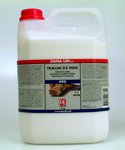Good advice: How to achieve a good result with wood glue

Dana Lim gives you good advice on how to achieve the best results with wood glue. Making a good gluing consists of two elements; to carry out the task optimally and to choose the right type of glue.
Perform the task optimally
To achieve the best gluing, you must ensure:
· That the products you are gluing fit together well to achieve full contact.
· That the wood has been freshly processed and can therefore be glued. If you are in doubt as to whether the wood is gluable, you can use the bead test:
o Put a drop of water on the wood you are going to glue. If the drop penetrates, it will be a good glue. If, on the other hand, the drop remains, it will not be a good glue. You can then sand the wood so that it becomes receptive to the glue.
· That you use the right amount of glue and the right pressing pressure. The optimal result is achieved if small drops of glue appear along the entire glue assembly after pressing.
· That the wood is kept under pressure until the glue has hardened.

Choose the right glue type
Two types are typically used for gluing wood; PVAc glue and PU glue. When choosing the type of glue, you must look at where the glue will be used. Moisture resistance in particular is decisive for whether you are going to use a PVAc glue or a PU glue. Below you will get an overview of the different moisture resistance classes, which are important to know when choosing the type of glue for your task.
| D1 | Indoors, where the temperature only rarely and briefly exceeds 50 °C, and the wood’s moisture content is a maximum of 15%. For example, furniture and fittings in dry rooms. |
| D2 | Indoors, where there is rare short-term exposure to running or condensed water and high humidity. The wood’s moisture content is a maximum of 18%. For example, furniture and fixtures, which are exposed to low humidity and fluctuating temperatures. |
| D3 | Indoors with frequent short-term exposure to running or condensed water and/or high humidity. Outdoors protected from the weather. For example, furniture and fittings in wet rooms, kitchen tables and wood exposed to high humidity. |
| D4 | Indoors with frequent, strong impacts from running or condensed water. Outdoors when affected by the weather, but with sufficiently covering surface treatment. For example, frame wood for windows and doors, garden furniture as well as wood and fixtures, which are exposed to a lot of moisture. |

PVAc glue: when gluing with PVAc glue, the moisture content of the wood must be between 7-15% and is only used for gluing wood. Use Trælim D2 Inde 490 (insert link) or Trælim D3 Ude 430 (insert link). To the latter, you can add a Dark Hardener 923 (insert link) or Hardener 921 (insert link), so it achieves D4 moisture resistance. There is a special variant, Trælim Vinter 465 , which can be stored and used in freezing conditions.

PU glue: when gluing with PU glue, the wood’s humidity must be between 12-20%. Below 12% moisture, moisten the wood before gluing. This glue type can glue wood with other materials, for example metal and certain laminates. Use Wood Glue PU Light 421 or Wood Glue PU Dark 422 .
If you want further information, you can contact our Technical Service .

